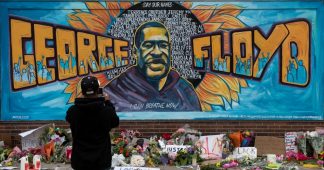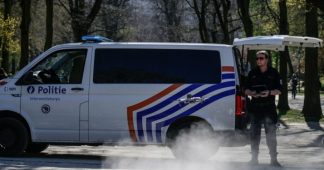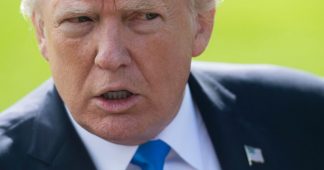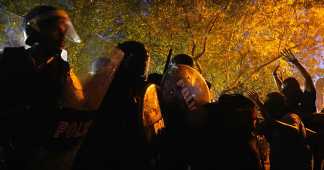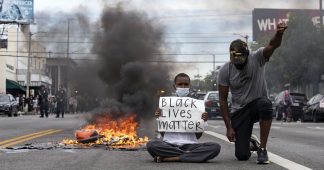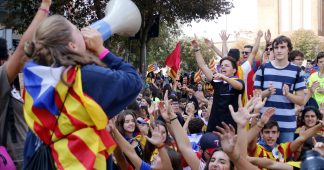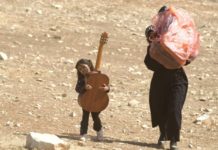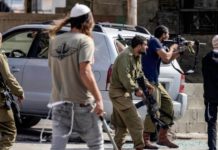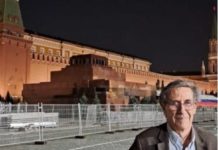by Dylan Brogan
June 1, 2020
After a second night of chaos in the streets of Madison, the organizers of a peaceful protest on May 30 against the police killing of George Floyd had a message for city leaders.
“We aren’t here to negotiate whether Black Lives Matter,” said M Adams, co-executive director of Freedom Inc., at a rally attended by about 100 people on June 1. “It is simple: You stop murdering black people and your glass will be safe.”
Representatives of Freedom Inc., Urban Triage, and the Party for Socialism and Liberation (PSL) — which led the large demonstration downtown on Saturday — repeatedly said they support the actions of people who have confronted police, defied curfews, broken windows, and looted businesses. Sawyer Johnson, with PSL, called out Madison Mayor Satya Rhodes-Conway, specifically, for trying to distinguish between peaceful protesters and those the police label as rioters.
“We have a white queer mayor…as a fellow white queer person, I got to have a conversation with her,” says Johnson. “We refuse to denounce any black, youth leader that is continuing to lead the rebellion. Because that’s what it is. We care more about black lives than Urban Outfitters getting tagged.”
The groups called on elected officials to abolish the police, allow community control over law enforcement, and to release inmates, who are disproportionately people of color, from the jail system. The community organizers also called for the firing of Matt Kenny, the Madison police officer who shot and killed 19-year-old Tony Robinson inside his Williamson Street home in 2015.
“It is clear to us that Madison’s liberalism only masks the true white supremacy nature of capitalism,” said Sawyer. “Not only does Matt Kenny still have his job, he’s training [police] on meditation.”
Adams compared the unrest in Madison this weekend to the Stonewall riots in June 1969 that helped launch the gay pride movement.
“The pride that white Madison enjoys and many LGBT people across the country enjoy was started by a rebellion. You all are the benefactors of rebellion,” said Adams. “Part of the terror of this society is they think cement is worth more than your life.”
After the impromptu rally, the group shut down downtown streets for several hours Monday afternoon. Madison police spokesperson Joel DeSpain, in an email, says the department is “making contingencies for whatever might take place” Monday night.
“We are, currently, keeping protesters safe as they move around the isthmus,” writes DeSpain.
Rhodes-Conway issued another curfew for Monday night in downtown Madison, starting at 9:30 p.m. Meanwhile, seven city alders sent a list of questions and a critical statement to Acting Police Chief Vic Wahl about his department’s actions Sunday, which were made in conjunction with several local law enforcement agencies and the Wisconsin National Guard.
“What we witnessed on the news last night was a gross and unnecessary display of force that deepens community divide and mistrust of the city and other bodies of government,” wrote Alds. Rebecca Kemble, Donna Moreland, Max Prestigiacomo, Arvina Martin, Marsha Rummel, Tag Evers and Grant Foster. “Instead of kneeling with protesters, MPD led a militarized police effort that escalated the situation with pepper spray, gassing, injuries, and harmful trauma to youth and others in the downtown area last night.”
The Madison Police Department had a day to prepare for a 9:30 p.m. curfew on May 31, issued by Rhodes-Conway after clashes with police and looting of businesses took place downtown and across the city on Saturday. Hundreds of protesters marched up State Street towards the Capitol Square, again, to protest Floyd’s death. Initially, police in standard uniforms kept their distance. But it wasn’t long before law enforcement in riot gear implemented a more aggressive strategy to disperse protesters. This included not just throwing cans of tear gas but launching canisters of the chemicals out of guns, shooting “non-lethal” projectiles at protesters, and deploying dozens more police officers.
Shortly before 10 p.m. the crowd moved from the top of State Street to South Pinckney Street. There — chanting “hands up, don’t shoot” — some protesters surrounded a few officers in standard uniforms.
Another small contingent of officers pushed past the protesters towards their colleagues. A surge of adrenaline pulsed through the crowd. According to media accounts from the scene, some pushing occurred between a couple of protesters and police. Acting Police Chief Wahl, on his blog later that evening, wrote: “Projectiles were thrown at the officers, and one individual struck an officer in the face.”
That marked the end of police officers in standard uniforms passively observing the protesters.
“They’re coming! They’re coming!” yelled one young man, as people scrambled.
Within moments, sirens blared and flashing red and blue lights from squad cars lit up the area. The “ping” of several tear gas canisters hitting cement sent protesters running away from a hissing cloud of chemical agents.
“Stay together. Stay together,” yelled several people trying to corral protesters fleeing in all directions.
Another line of officers in riot gear stood ready a block away, ensuring protesters could not enter State Street. The crowd was flanked by police on two sides of Mifflin, soon to be three. At 10:10 p.m., the black silhouettes of police in riot gear could be seen marching in lockstep up to the Capitol against a fog of tear gas.
Some protesters fled up Wisconsin Avenue, the only means of retreat. But the majority did not yield. A line of more than a dozen officers, wielding batons, walked slowly towards the crowd. Another dozen officers formed a line behind them. Some protesters stood their ground and knelt with their hands up before the officers.
“This is not a riot, this is a revolution,” rang out again and again as protesters refused to move. More people then joined the protest line and even more officers came forward with riot shields to form a thick wall of bodies in the middle of the street.
“Stand up, don’t shoot! Stand up don’t shoot!” chanted the protesters as law enforcement readied more tactics to disperse the protesters.
Police then shot the protesters with pepper spray, which burns the face, eyes and lungs. Loud flash grenades really got the crowd moving up Wisconsin Avenue. Even more tear gas canisters bounced toward retreating protesters, who headed up towards Lake Mendota. Loud bangs rang out again, and again, and tear gas canisters shot past the throngs. One canister nearly caught some brush on fire but a protester put it out. Police kept advancing, block by block, through the smoke. Protesters keep chanting.
“What’s his name? George Floyd. What’s his name? George Floyd,” shouted the crowd as police marched forward. “No justice, no peace. No justice, no peace.”
But protesters fled again after people started shouting “rubber bullets, rubber bullets,” as officers continued marching forward. A young black man, in front of this reporter, said he was hit by something.
“I’m not sure what it was. But it hit my leg,” said the man. He quickly found a blue foam-tip projectile, launched out of a modified grenade launcher, and stuck it in his pocket. During the first night of unrest on State Street, police did not use this type of “non-lethal” weaponry against people. DeSpain praised his department, the day before, for not shooting rubber bullets at protesters as has been done in other cities across the country.
At the top of Gilman and Wisconsin, near the Edgewater Hotel, protesters had to decide whether to head down Gilman towards James Madison Park or towards State Street. Several motorcycles appeared out of nowhere and revved their engines to the delight of the crowd. Police drones buzzed overhead. A few minutes passed before law enforcement moved against the crowd again, this time very quickly. Protesters were hit with another round of projectiles which sent people in both directions on Gilman.
The vast majority of the crowd was successfully broken up by 11 p.m. A group of around two dozen protesters retreated into the Mansion Hill neighborhood. People surrounded and offered help to a man, slightly older than most of the young crowd, who was bleeding from a projectile that hit just above his eye.
“This man is a hero of the revolution,” someone yelled. Some walked away towards James Madison Park, seemingly satisfied and ready to go home. Others headed back downtown to find protesters still intent on confronting police.
The Madison Police Department had a day to prepare for a 9:30 p.m. curfew on May 31, issued by Rhodes-Conway after clashes with police and looting of businesses took place downtown and across the city on Saturday. Hundreds of protesters marched up State Street towards the Capitol Square, again, to protest Floyd’s death. Initially, police in standard uniforms kept their distance. But it wasn’t long before law enforcement in riot gear implemented a more aggressive strategy to disperse protesters. This included not just throwing cans of tear gas but launching canisters of the chemicals out of guns, shooting “non-lethal” projectiles at protesters, and deploying dozens more police officers.
Shortly before 10 p.m. the crowd moved from the top of State Street to South Pinckney Street. There — chanting “hands up, don’t shoot” — some protesters surrounded a few officers in standard uniforms.
Another small contingent of officers pushed past the protesters towards their colleagues. A surge of adrenaline pulsed through the crowd. According to media accounts from the scene, some pushing occurred between a couple of protesters and police. Acting Police Chief Wahl, on his blog later that evening, wrote: “Projectiles were thrown at the officers, and one individual struck an officer in the face.”
That marked the end of police officers in standard uniforms passively observing the protesters.
“They’re coming! They’re coming!” yelled one young man, as people scrambled.
Within moments, sirens blared and flashing red and blue lights from squad cars lit up the area. The “ping” of several tear gas canisters hitting cement sent protesters running away from a hissing cloud of chemical agents.
“Stay together. Stay together,” yelled several people trying to corral protesters fleeing in all directions.
Another line of officers in riot gear stood ready a block away, ensuring protesters could not enter State Street. The crowd was flanked by police on two sides of Mifflin, soon to be three. At 10:10 p.m., the black silhouettes of police in riot gear could be seen marching in lockstep up to the Capitol against a fog of tear gas.
Some protesters fled up Wisconsin Avenue, the only means of retreat. But the majority did not yield. A line of more than a dozen officers, wielding batons, walked slowly towards the crowd. Another dozen officers formed a line behind them. Some protesters stood their ground and knelt with their hands up before the officers.
“This is not a riot, this is a revolution,” rang out again and again as protesters refused to move. More people then joined the protest line and even more officers came forward with riot shields to form a thick wall of bodies in the middle of the street.
“Stand up, don’t shoot! Stand up don’t shoot!” chanted the protesters as law enforcement readied more tactics to disperse the protesters.
Police then shot the protesters with pepper spray, which burns the face, eyes and lungs. Loud flash grenades really got the crowd moving up Wisconsin Avenue. Even more tear gas canisters bounced toward retreating protesters, who headed up towards Lake Mendota. Loud bangs rang out again, and again, and tear gas canisters shot past the throngs. One canister nearly caught some brush on fire but a protester put it out. Police kept advancing, block by block, through the smoke. Protesters keep chanting.
“What’s his name? George Floyd. What’s his name? George Floyd,” shouted the crowd as police marched forward. “No justice, no peace. No justice, no peace.”
But protesters fled again after people started shouting “rubber bullets, rubber bullets,” as officers continued marching forward. A young black man, in front of this reporter, said he was hit by something.
“I’m not sure what it was. But it hit my leg,” said the man. He quickly found a blue foam-tip projectile, launched out of a modified grenade launcher, and stuck it in his pocket. During the first night of unrest on State Street, police did not use this type of “non-lethal” weaponry against people. DeSpain praised his department, the day before, for not shooting rubber bullets at protesters as has been done in other cities across the country.
At the top of Gilman and Wisconsin, near the Edgewater Hotel, protesters had to decide whether to head down Gilman towards James Madison Park or towards State Street. Several motorcycles appeared out of nowhere and revved their engines to the delight of the crowd. Police drones buzzed overhead. A few minutes passed before law enforcement moved against the crowd again, this time very quickly. Protesters were hit with another round of projectiles which sent people in both directions on Gilman.
The vast majority of the crowd was successfully broken up by 11 p.m. A group of around two dozen protesters retreated into the Mansion Hill neighborhood. People surrounded and offered help to a man, slightly older than most of the young crowd, who was bleeding from a projectile that hit just above his eye.
“This man is a hero of the revolution,” someone yelled. Some walked away towards James Madison Park, seemingly satisfied and ready to go home. Others headed back downtown to find protesters still intent on confronting police.
